Using Partnerships and Community Science to Protect Wild and Scenic Rivers in the Eastern United States
Abstract
1. Introduction
2. The Partnership Wild and Scenic Rivers Framework
2.1. Using the Wild and Scenic Rivers Act for Partnerships
2.2. Using the Clean Water Act to Protect Wild and Scenic Rivers
2.3. The Niche for “Community Science” in Water Quality Monitoring
3. Establishing Rigor and Trust in Community-Based Data Collection
3.1. Case Study 1: Monitoring Water Quality Impacts of Dam Removal
3.1.1. The Musconetcong River Setting
3.1.2. Using Data to Build Community Support
3.1.3. Approach
- Site 1:
- Wadeable local reference site to represent more natural riffle-run conditions upstream of planned in-stream work.
- Site 2:
- Non-wadeable site within the impoundment with run, no riffle habitat, likely to be impacted by the dam removal.
- Site 3:
- Wadeable site with riffle-run habitat, downstream of the dam removal.
- Site 4:
- Wadeable site with riffle-run conditions downstream of the dam removal, not likely to be affected by in-stream work.
3.2. Case Study 2: Monitoring Water Quality Impacts of Wastewater Treatment
3.2.1. The Sudbury, Assabet and Concord Rivers Setting
3.2.2. Adding Science from the Ground Up
3.2.3. Approach
3.2.4. The Partnerships That Bring Progress
4. Results: Progress in Restoring River Health
4.1. Musconetcong River
4.2. Sudbury, Assabet and Concord Rivers
4.3. Co-Benefits of Community Science
5. Discussion
6. Conclusions
Author Contributions
Funding
Data Availability Statement
Acknowledgments
Conflicts of Interest
References
- Palmer, M.; Letttenmaier, D.P.; Poff, N.L.; Postel, S.L.; Richter, B.; Warner, R. Climate change and river ecosystems: Protection and adaptation options. Environ. Manag. 2009, 44, 1053–1068. [Google Scholar] [CrossRef] [PubMed]
- United States Statutes at Large. The Clean Water Act, 33 U.S.C. §1251 et seq. of 1972; Based on the Federal Water Pollution Control Act of 1948 (Ch. 758; P.L. 845); U.S. Government Printing Office: Washington, DC, USA, 1973.
- Raabe, J.K.; Hightower, J.E. American shad migratory behavior, weight loss, survival, and abundance in a North Carolina River following dam removals. Trans. Am. Fish. Soc. 2014, 143, 673–688. [Google Scholar] [CrossRef]
- Division of Ecological Restoration. River Restoration: Dam Removal. 2020. Available online: https://www.mass.gov/river-restoration-dam-removal (accessed on 24 November 2020).
- Hamilton, P.; Craig, L. Restoring free-flowing rivers: Bringing down the dams. N. J. Fish Wildl. Digest. 2017, 2017, 9–11. [Google Scholar]
- United States Statute at Large. Wild and Scenic Rivers Act, 1968. Public Law 90-542; 16 U.S.C. 1271 et seq; U.S. Government Printing Office: Washington, DC, USA, 1969.
- Jennings, S. Celebrating forty years of the Wild and Scenic Rivers Act. Georg. Wright Forum 2008, 25, 15–26. [Google Scholar]
- U.S. Department of the Interior. River Mileage Classifications for Components of the National Wild and Scenic Rivers System—April 2019, Wild and Scenic Rivers Table. Available online: https://www.rivers.gov/documents/rivers-table.pdf (accessed on 24 November 2020).
- Partnership Wild and Scenic Rivers Program. Available online: https://www.nps.gov/orgs/1912/partnership-wild-and-scenic-rivers.htm (accessed on 24 November 2020).
- U.S. Department of the Interior. Budget Justification and Performance Information, Fiscal Year 2021; National Park Service; U.S. Department of the Interior: Washington, DC, USA, 2020.
- Fosburgh, J.; DiBello, J.; Akers, F. Partnership Wild and Scenic Rivers. Georg. Wright Forum 2008, 25, 37–44. [Google Scholar]
- Sudbury, Assabet & Concord Wild & Scenic River Stewardship Council. Available online: http://www.sudbury-assabet-concord.org/the-rivers/ws-rivers (accessed on 24 November 2020).
- About Us, Musconetcong Watershed Association. Available online: https://www.musconetcong.org (accessed on 24 November 2020).
- Powell, M. Building a national water quality monitoring program. Environ. Sci. Technol. 1995, 29, 458–463. [Google Scholar] [CrossRef] [PubMed]
- Executive Office of Environmental Affairs. Massachusetts Watershed Initiative: 1999 Program Guide; Executive Office of Environmental Affairs: Boston, MA, USA, 1999.
- New Jersey Water Monitoring Council. Available online: https://www.nj.gov/dep/wms/wmcchome.html (accessed on 24 November 2020).
- Firehock, K.; West, J. A brief history of volunteer biological water monitoring using macroinvertebrates. J. N. Am. Benthol. Soc. 1995, 14, 197–202. [Google Scholar] [CrossRef]
- Izaak Walton League of America, About Us. Available online: www.iwla.org (accessed on 24 November 2020).
- United States Environmental Protection Agency. Building Partnerships in the Year of Clean Water. In Proceedings of the Third National Citizens’ Volunteer Water Monitoring Conference, EPA, Office of Water, Washington, DC, USA, 29 March–2 April 1992. EPA 841-R-92-004. [Google Scholar]
- Riesch, H.; Potter, C. Citizen science as seen by scientists: Methodological, epistemological and ethical dimensions. Public Understand. Sci. 2014, 23, 107–120. [Google Scholar] [CrossRef]
- Pandya, R. What Is Community Science? Available online: https://thrivingearthexchange.org/what-is-community-science-a-blog-and-a-quiz/ (accessed on 11 January 2021).
- Audubon. Why We’re Changing from ‘Citizen Science’ to ‘Community Science’. Available online: https://debspark.audubon.org/news/why-were-changing-citizen-science-community-science (accessed on 7 January 2021).
- Loperfido, J.V.; Beyer, P.; Just, C.L.; Schnoor, J.L. Uses and biases of volunteer water quality data. Environ. Sci. Technol. 2010, 44, 7133–7199. [Google Scholar] [CrossRef] [PubMed]
- New Jersey Water Supply Authority. Raritan Basin: Portrait of a Watershed; Raritan Basin Watershed Management Project; NJWSA: Clinton, NJ, USA, 2002. [Google Scholar]
- Massachusetts Department of Environmental Protection. Massachusetts Watershed Initiative Program: Indicative Project Summaries; Massachusetts Department of Environmental Protection: Boston, MA, USA, 1999.
- Ward, R.C. Water quality monitoring: Where’s the beef? Water Resour. Bull. 1996, 32, 673–680. [Google Scholar] [CrossRef]
- United States Environmental Protection Agency. Information to Action—Strengthening EPA Citizen Science Partnerships for Environmental Protection; United States Environmental Protection Agency: Washington, DC, USA, 2018.
- United States Environmental Protection Agency. Handbook for Citizen Science Quality Assurance and Documentation; Get Involved with Citizen Science for Environmental Protection; United States Environmental Protection Agency: Washington, DC, USA, 2019; p. 206-B-18-001. Available online: www.epa.gov/citizen-science (accessed on 24 November 2020).
- About the Musconetcong. Available online: https://www.musconetcong.org/about-the-musconetcong (accessed on 24 November 2020).
- Musconetcong River Management Council. Musconetcong River National Wild and Scenic Rivers Study: River Management Plan; Musconetcong River Management Council: Asbury, NJ, USA, 2003. [Google Scholar]
- State Program Statistics. Available online: https://damsafety.org/new-jersey (accessed on 24 November 2020).
- Musconetcong Advisory Committee; Musconetcong Watershed Association; Heritage Conservancy; National Park Service. Musconetcong River National Wild and Scenic Rivers Study: River Management Plan; National Park Service: Washington, DC, USA, 2003; pp. 7–8. Available online: https://www.rivers.gov/documents/plans/musconetcong-plan.pdf (accessed on 24 November 2020).
- New Jersey Department of Environmental Protection. Green Acres Program, Program Areas. Available online: https://www.nj.gov/dep/greenacres/blue_flood_ac.html (accessed on 24 November 2020).
- Gulf of Maine Council on the Marine Environment. Stream Barrier Removal Monitoring Guide. 2007. Available online: Stream-Barrier-Removal-Monitoring-Guide.pdf (accessed on 27 November 2020).
- United States Department of Agriculture. Environmental Assessment Lower Musconetcong River Restoration Project Finesville Dam Vicinity; USDA Natural Resources Conservation Service and Cooperating Agencies, USDA Natural Resources Conservation Service: Somerset, NJ, USA, 2010. Available online: https://www.nrcs.usda.gov/Internet/FSE_DOCUMENTS/nrcs141p2_018307.pdf (accessed on 27 November 2020).
- Cummins, K.W.; Klug, M.J. Feeding ecology of stream invertebrates. Ann. Rev. Ecol. Syst. 1979, 10, 147–172. [Google Scholar] [CrossRef]
- New Jersey Department of Environmental Protection. Development of the New Jersey High Gradient Macroinvertebrate Index (HGMI). Available online: https://www.nj.gov/dep/wms/bfbm/download/HGMI_report.pdf (accessed on 27 November 2020).
- United States Environmental Protection Agency. Habitat Assessment and Physiochemical Parameters. Ch. 5 (part B) in Habitat: Water: Bioassessment. Available online: https://archive.epa.gov/water/archive/web/html/ch05b.html (accessed on 30 November 2020).
- Hilsenhoff, W.L. An improved biotic index of organic stream pollution. Great Lakes Entomol. 1987, 20, 31–39. [Google Scholar]
- Roberts-Lawler, N.; Styler Barry, B. Assessing Dam Removals on a Shoe-String: Using Underwater Photos to Complement Bug Data. In Proceedings of the Eighth National Monitoring Conference; Water: One Resource–Shared Effort–Common Future, Portland, OR, USA, 30 April–4 May 2012. [Google Scholar]
- Stewardship, The Sudbury, Assabet & Concord Wild & Scenic River Stewardship Council. Available online: http://www.sudbury-assabet-concord.org/the-organization/river-stewardship-council (accessed on 24 November 2020).
- Department of Environmental Protection. Massachusetts Section 303(d) List of Waters, 1998; Division of Watershed Management: Worcester, MA, USA, 1999.
- OARS. Assabet River Water Quality Monitoring Program Final Report, 1999; OARS: Concord, MA, USA, 2000; p. 4. Available online: http://www.oars3rivers.org/river/waterquality/reports (accessed on 24 November 2020).
- United States Environmental Protection Agency. Six Municipalities, One Watershed: A Collaborative Approach to Remove Phosphorus in the Assabet River Watershed EPA 820-R-15-097; Office of Water: Washington, DC, USA, 2015.
- OARS. Water Quality Monitoring Program Final Report: 2018–2019 Field Seasons; OARS: Concord, MA, USA, 2020. [Google Scholar]
- Massachusetts Department of Environmental Protection. Assabet River Total Maximum Daily Load for Phosphorus, Report No: MA82B-01-2004-01; Massachusetts Department of Environmental Protection: Boston, MA, USA, 2004; p. 5.
- Savoie, J.G.; DeSimone, L.A.; Mullaney, J.R.; Zimmerman, M.J.; Waldron, M.C. Changes in Phosphorus Concentrations and Loads in the Assabet River, Massachusetts, October 2008 through April 2014; U.S. Geological Survey Scientific Investigations Report 2016-5063; U.S. Geological Survey: Reston, VA, USA, 2016.
- Zimmerman, M.J.; Qian, Y.; Tian, Y.Q. Monitoring to Assess Progress toward Meeting the Assabet River, Massachusetts, Phosphorus Total Maximum Daily Load—Aquatic Macrophyte Biomass and Sediment-Phosphorus Flux; U.S. Geological Survey Scientific Investigations Report 2011-5179; U.S. Geological Survey: Reston, VA, USA, 2011; p. 77.
- U.S. Army Corps of Engineers. Assabet River, Massachusetts: Sediment and Dam Removal Feasibility Study; Department of the Army, New England District: Concord MA, USA, 2010; Available online: https://www.nae.usace.army.mil/Missions/Projects-Topics/Assabet-River-Study/ (accessed on 25 November 2020).
- Independent Sector, Value of Volunteer Time. Available online: https://independentsector.org/value-of-volunteer-time-2020 (accessed on 25 November 2020).
- Massachusetts Department of Environmental Protection. SuAsCo Watershed 2001 Water Quality Assessment Report; Report Number 82-AC-1; Executive Office of Environmental Affairs: Boston, MA, USA, 2005.
- Musconetcong Watershed Association. Evaluation of Stream Bed Manipulation in Cold Water Fisheries; NRCS Conservation Innovation Grant # 69-2B29-12-178; Musconetcong Watershed Association: Asbury, NJ, USA, 2015. [Google Scholar]
- New Jersey Department of Environmental Protection. American Shad Return to Musconetcong River in Hunterdon and Warren Counties after More than a Century; NJDEP Press: Trenton, NJ, USA, 2017.
- Union of Concerned Scientists. Fact Sheet: Killer Heat. Extreme Heat in Massachusetts 3rd District; Union of Concerned Scientists: Cambridge, MA, USA, 2019. [Google Scholar]
- Environment America. When It Rains, It Pours Global Warming and the Increase in Extreme Precipitation from 1948 to 2011; Environment America: Washington, DC, USA, 2012. [Google Scholar]
- Department of Agriculture. U.S. Drought Monitor Northeast. 23 August 2016. Available online: https://www.ncdc.noaa.gov/news/us-drought-monitor-update-august-23-2016 (accessed on 25 November 2020).
- Department of Agriculture. U.S. Drought Monitor Northeast. 29 September 2020. Available online: https://www.ncei.noaa.gov/news/us-drought-monitor-update-september-29-2020 (accessed on 25 November 2020).
- United States Environmental Protection Agency. Authorization to Discharge under the National Pollutant Discharge Elimination System, 2020 Draft Permit, No. MA0100412, Fact Sheet; 16. EPA Region 1; United States Environmental Protection Agency: Boston, MA, USA, 2020.
- Vaughan, I.P.; Gotelli, N.J. Water quality improvements offset the climatic debt for stream macroinvertebrates over twenty years. Nat. Commun. 2019, 10, 1956. [Google Scholar] [CrossRef]
- Doyle, M. America’s rivers and the American experiment. J. Am. Water Resour. Assoc. 2012, 48, 820–837. [Google Scholar] [CrossRef]
- United States Department of Agriculture. Why Volunteer Water Quality Monitoring Makes Sense, Volunteer Water Quality Monitoring National Facilitation Project Factsheet II, 2002 updated; United States Department of Agriculture: Washington, DC, USA, 2010. Available online: https://acwi.gov/monitoring/vm/publications/articles/article_Why_Makes_Sense.pdf (accessed on 30 November 2020).
- Storey, R.G.; Wright-Stow, A.; Kin, E.; Davies-Colley, R.; Stott, R. Volunteer stream monitoring: Do the data quality and monitoring experience support increased community involvement in freshwater decision making? Ecol. Soc. 2016, 21, 32. [Google Scholar] [CrossRef]
- United States Environmental Protection Agency. EPA Response to Comments on National Pollutant Discharge Elimination System (NPDES) General Permits for Stormwater Discharges from Small Municipal Separate Storm Sewer Systems in Massachusetts; NPDES Permit No. MAR041000, MAR042000, and MAR043000. April 4; EPA Region 1; United States Environmental Protection Agency: Boston, MA, USA, 2016.
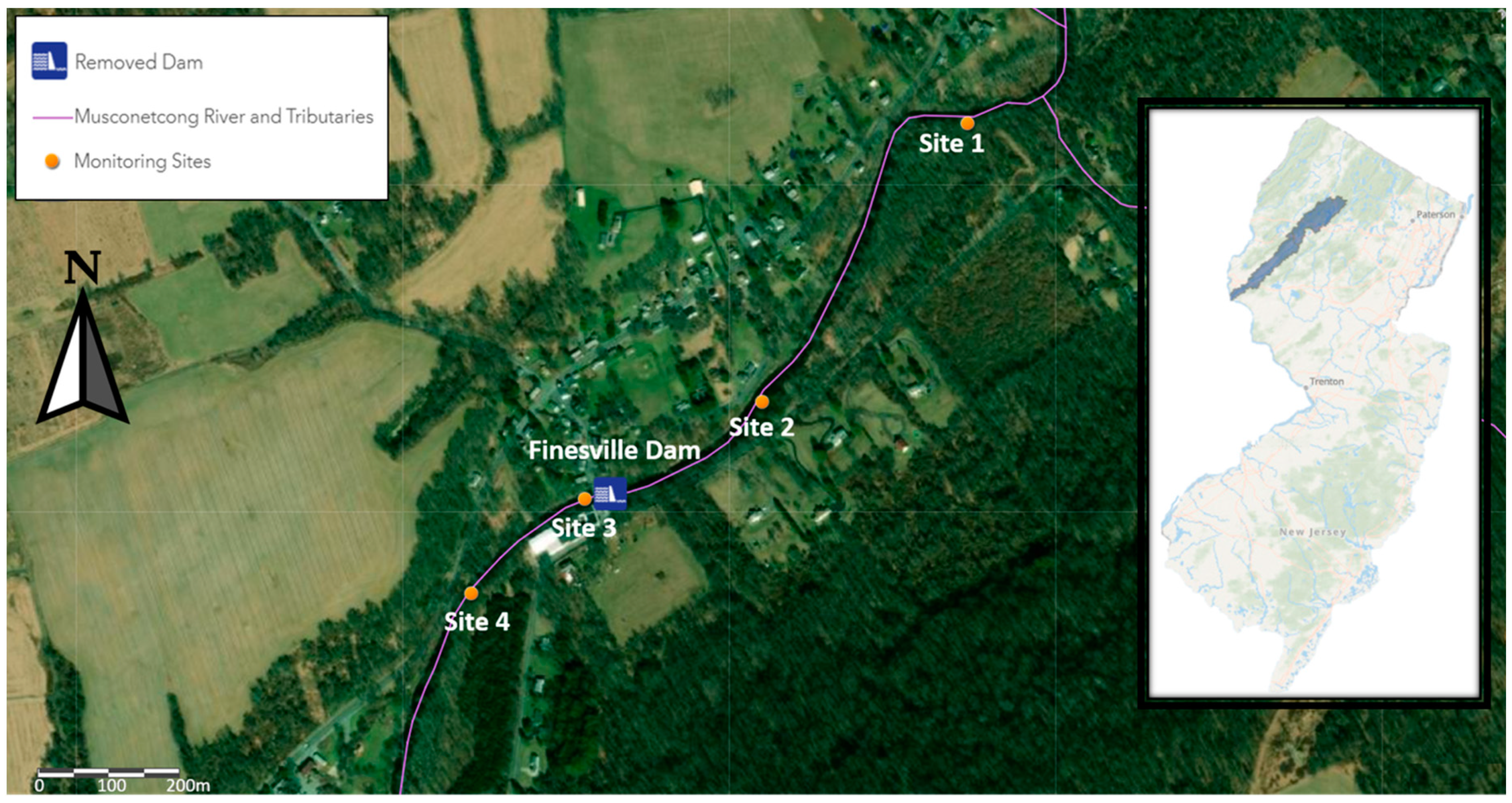
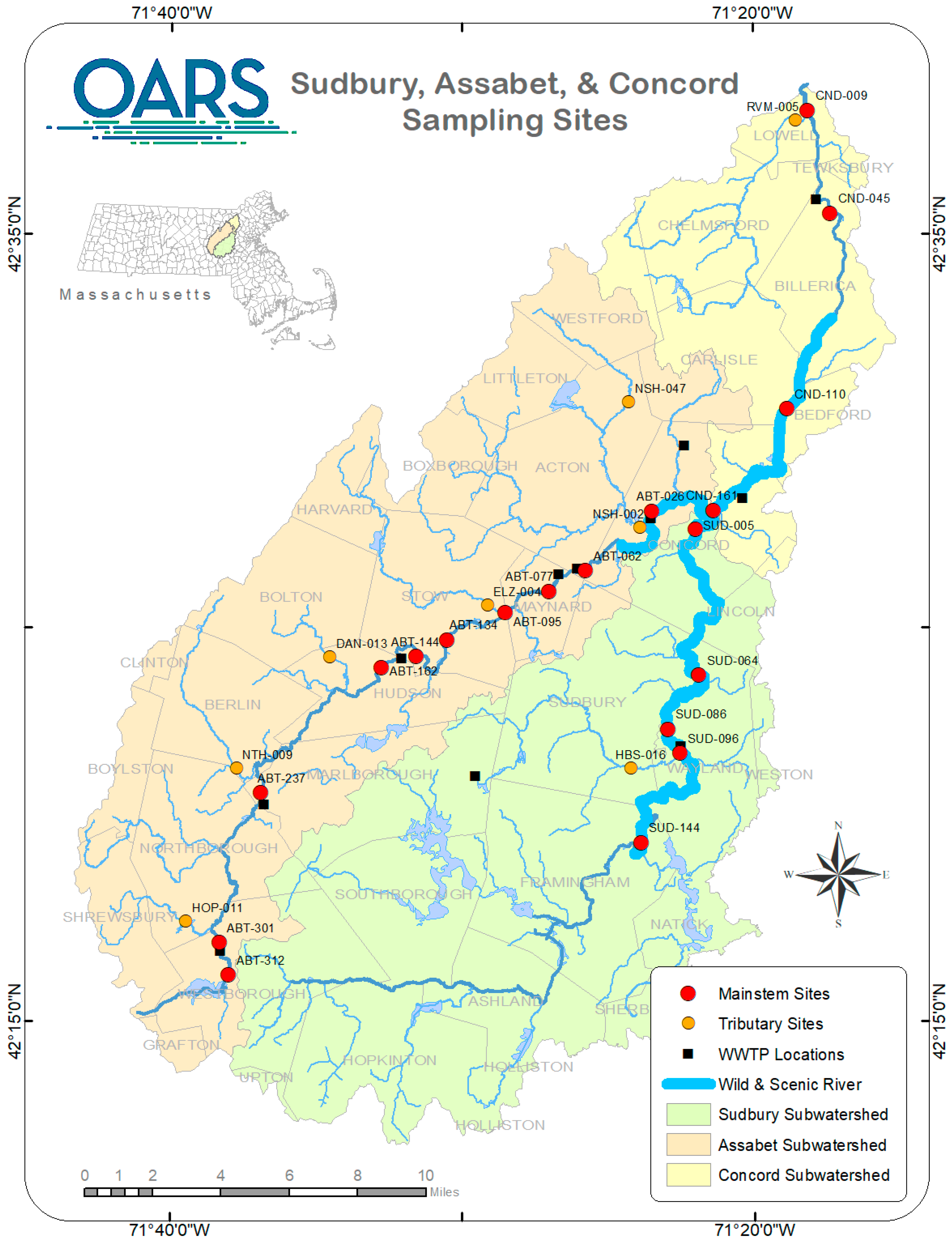
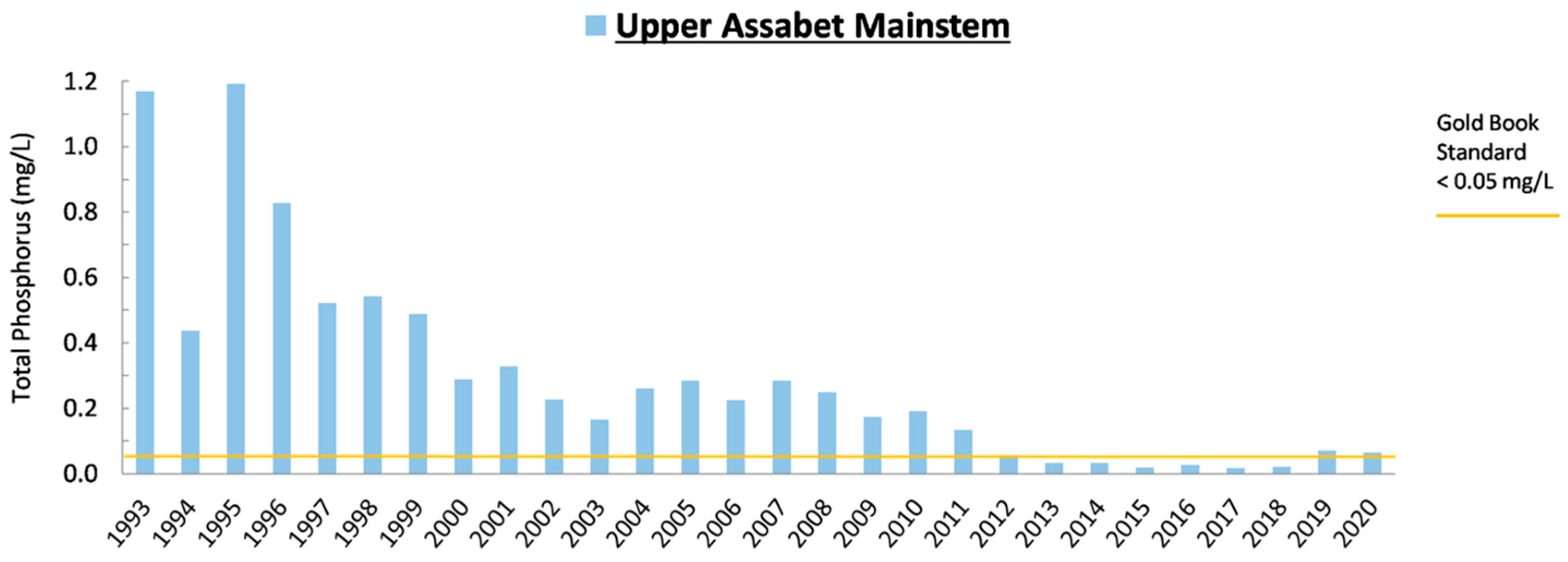
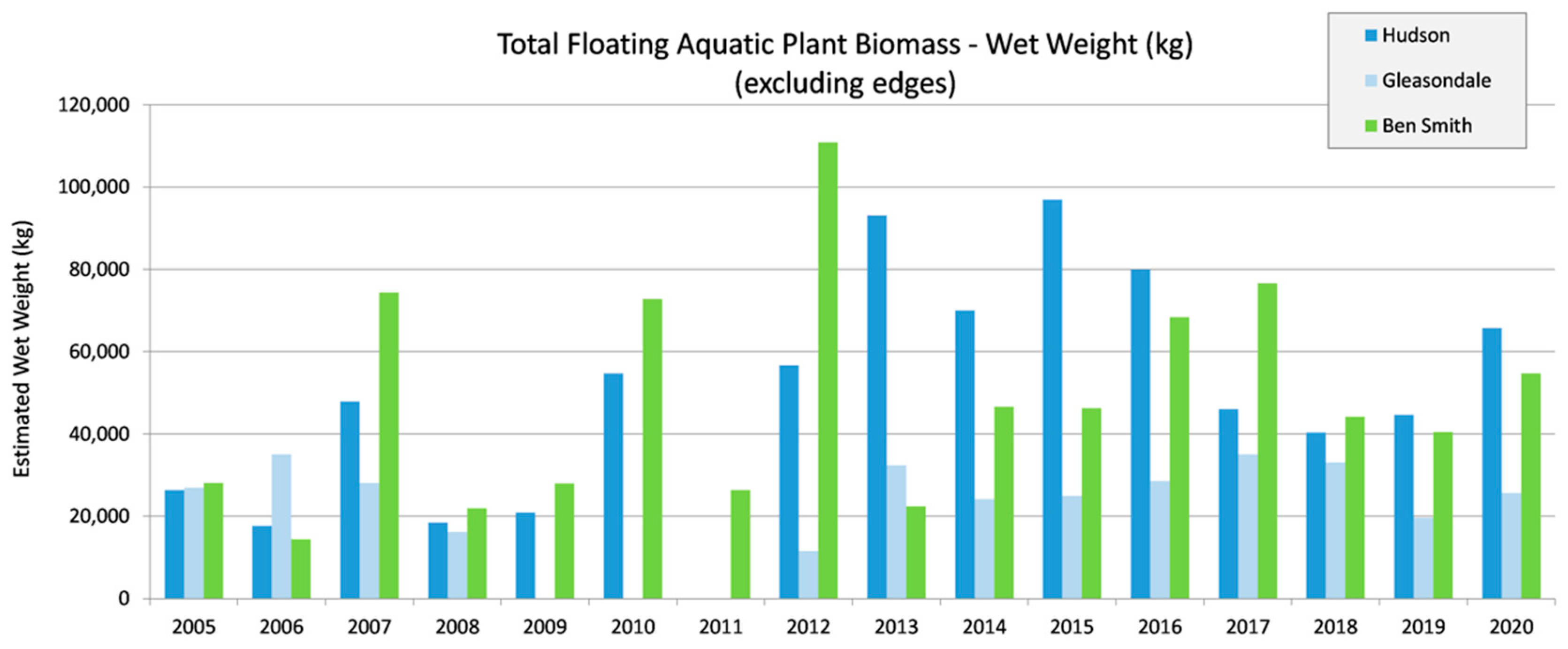

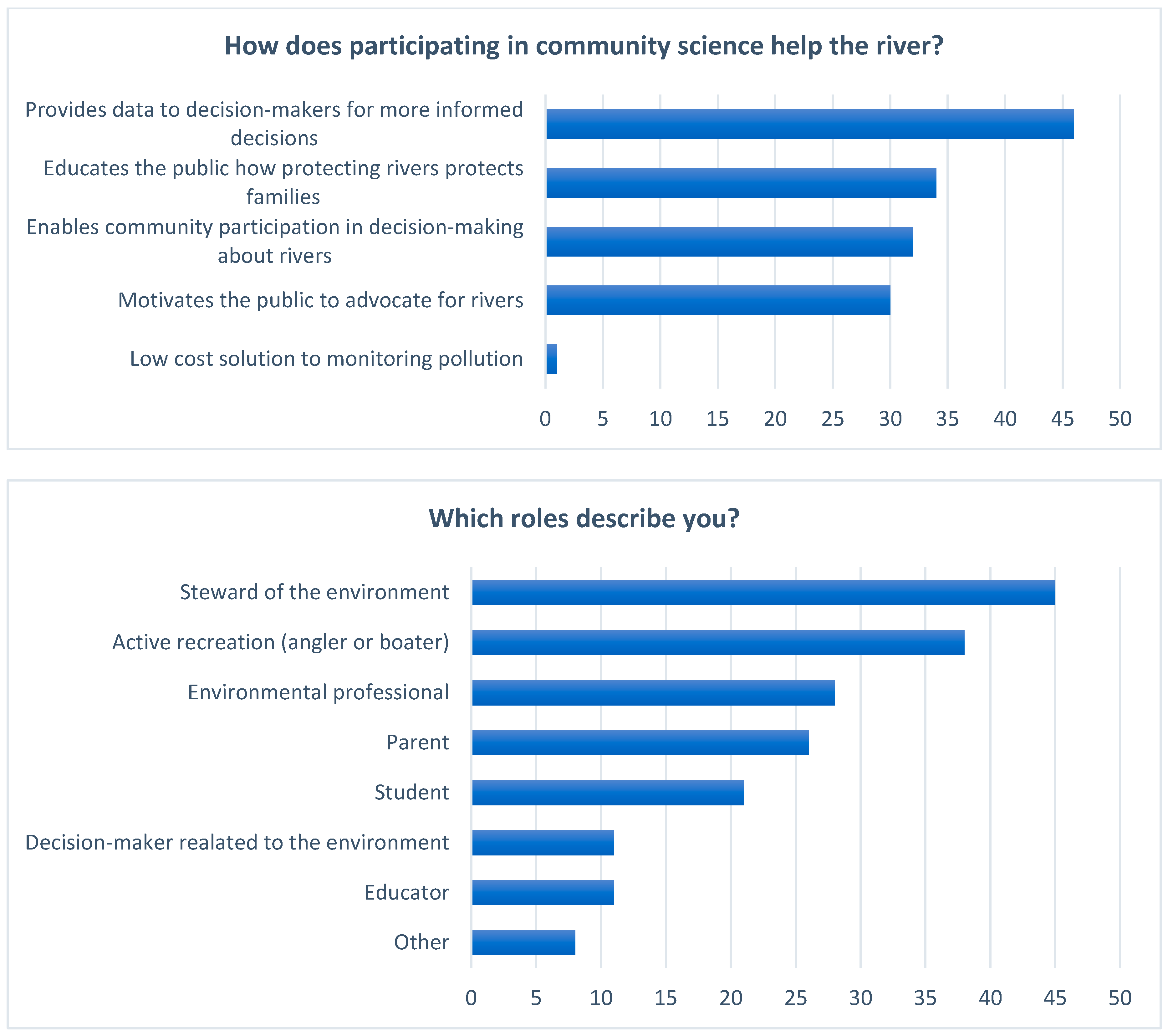
| Characteristic | Musconetcong, New Jersey | SuAsCo, Massachusetts |
|---|---|---|
| Watershed area/river length | 404 sq km/74 km | 1036 sq km/142 km |
| Year designated W&S | 2006 | 1999 |
| Outstanding W&S Values | Recreational fishing, scenic views, wildlife habitat, and unique history | Ecology, scenery, recreation, history, place in American literature |
| Km designated W&S | 39 + 6.9 (pending) | 46.7 |
| River Council partners | 14 + 1 (pending) municipal, 4 counties, 1 watershed non-profit, 2 other non-profits | 2 federal, 1 state, 8 municipal, 1 watershed non-profit, 1 land trust non-profit |
| Year watershed association founded | 1992 | 1986 |
| Non-profit staff/science volunteers (2019–2020) | 7 staff/25 volunteers 2 part-time science staff | 4 staff/41 volunteers 1 part-time science staff |
| Year QAPP developed | 2010 | 2000 |
| Data types, parameters | Percent EPT 1, macroinvertebrates, photographs of streambed and banks, habitat | Temp., pH, dissolved oxygen, conductivity, total suspended solids, total phosphorus, orthophosphate, nitrate-N, ammonia-N, chloride, chlorophyll-a, water depth, plant biomass |
| Monitoring funding sources | National Park Service (NPS), The Watershed Institute, member contributions | NPS, State legislature/MassDEP, Cedar Tree Foundation, environmental penalty, member contributions |
| Assessment | Site 1 | Site 2 | Site 3 | Site 4 |
|---|---|---|---|---|
| Pre-removal, 2010 Spring | ||||
| Biological Condition | Excellent | Poor | Excellent | Good |
| NJ HGMI | 67.25 | 17.53 | 69.64 | 56.41 |
| % EPT | 76.59 | 32.54 | 53.97 | 62.12 |
| Habitat Score | 159 | 32 | 110 | 135 |
| Habitat Assessment | Sub-optimal | Poor | Sub-optimal | Sub-optimal |
| Post-removal, 2012 | ||||
| Biological Condition | Excellent | Excellent | Excellent | Good |
| NJ HGMI | 78.69 | 80.61 | 72.93 | 57.02 |
| % EPT | 70.23 | 66.30 | 54.61 | 45.02 |
| Habitat Score | 158 | 77 | 100 | 125 |
| Habitat Assessment | Sub-optimal | Marginal | Sub-optimal | Sub-optimal |
Publisher’s Note: MDPI stays neutral with regard to jurisdictional claims in published maps and institutional affiliations. |
© 2021 by the authors. Licensee MDPI, Basel, Switzerland. This article is an open access article distributed under the terms and conditions of the Creative Commons Attribution (CC BY) license (http://creativecommons.org/licenses/by/4.0/).
Share and Cite
Field-Juma, A.; Roberts-Lawler, N. Using Partnerships and Community Science to Protect Wild and Scenic Rivers in the Eastern United States. Sustainability 2021, 13, 2102. https://doi.org/10.3390/su13042102
Field-Juma A, Roberts-Lawler N. Using Partnerships and Community Science to Protect Wild and Scenic Rivers in the Eastern United States. Sustainability. 2021; 13(4):2102. https://doi.org/10.3390/su13042102
Chicago/Turabian StyleField-Juma, Alison, and Nancy Roberts-Lawler. 2021. "Using Partnerships and Community Science to Protect Wild and Scenic Rivers in the Eastern United States" Sustainability 13, no. 4: 2102. https://doi.org/10.3390/su13042102
APA StyleField-Juma, A., & Roberts-Lawler, N. (2021). Using Partnerships and Community Science to Protect Wild and Scenic Rivers in the Eastern United States. Sustainability, 13(4), 2102. https://doi.org/10.3390/su13042102






